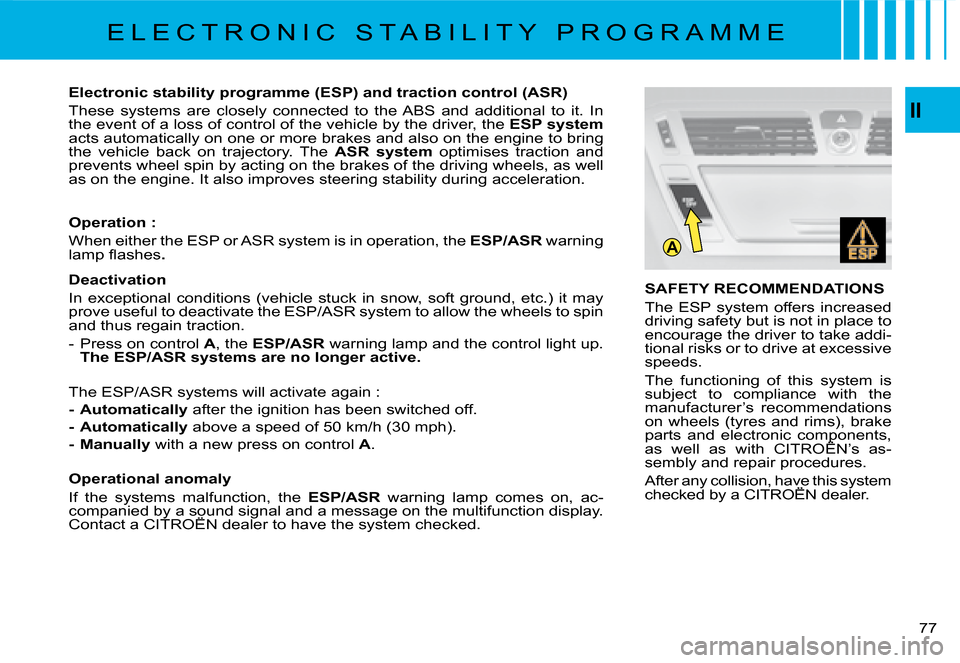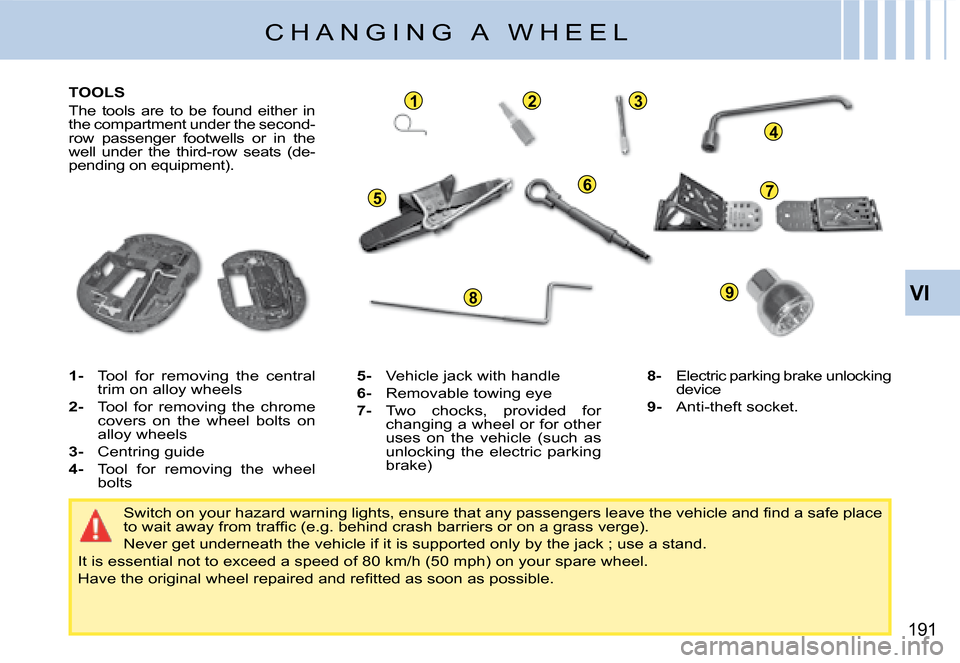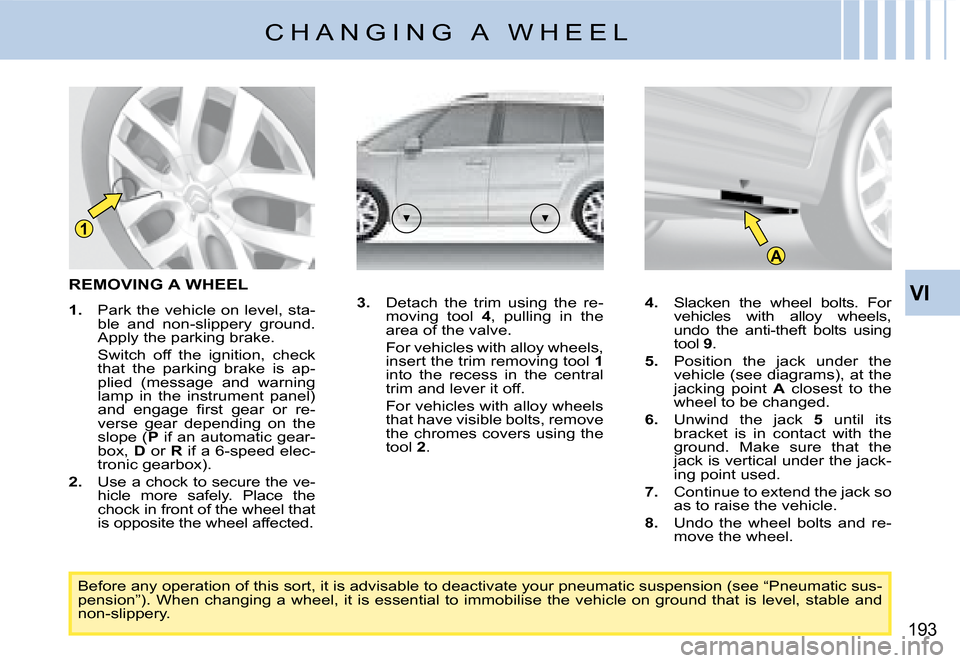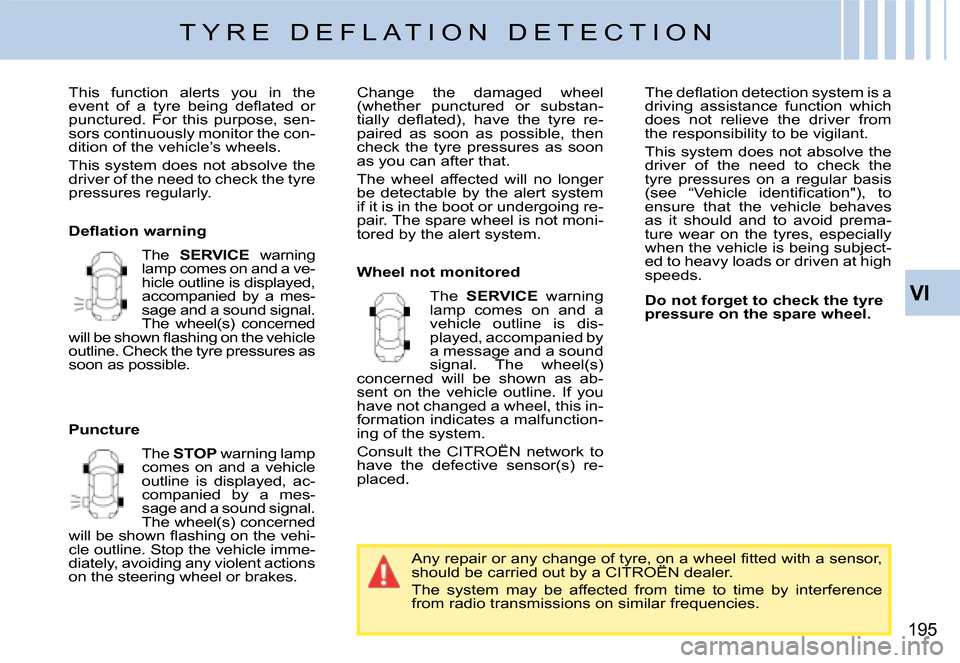brake Citroen C4 PICASSO 2008 1.G Owner's Guide
[x] Cancel search | Manufacturer: CITROEN, Model Year: 2008, Model line: C4 PICASSO, Model: Citroen C4 PICASSO 2008 1.GPages: 266, PDF Size: 7.14 MB
Page 76 of 266

A
II
77
SAFETY RECOMMENDATIONS
The ESP system offers increased driving safety but is not in place to encourage the driver to take addi-tional risks or to drive at excessive speeds.
The functioning of this system is subject to compliance with the manufacturer’s recommendations on wheels (tyres and rims), brake parts and electronic components, as well as with CITROËN’s as-parts and electronic components, components,
sembly and repair procedures.
After any collision, have this system checked by a CITROËN dealer.After any collision, have this system , have t
Electronic stability programme (ESP) and traction control (ASR)
These systems are closely connected to the ABS and additional to it. In the event of a loss of control of the vehicle by the driver, the ESP system acts automatically on one or more brakes and also on the engine to bring the vehicle back on trajectory. The ASR system optimises traction and prevents wheel spin by acting on the brakes of the driving wheels, as well as on the engine. It also improves steering stability during acceleration.
Operation :
When either the ESP or ASR system is in operation, the ESP/ASR warning �l�a�m�p� �fl� �a�s�h�e�s.
Deactivation
In exceptional conditions (vehicle stuck in snow, soft ground, e tc.) it may prove useful to deactivate the ESP/ASR system to allow the wheels to spin and thus regain traction.
- Press on control A, the ESP/ASR warning lamp and the control light up. The ESP/ASR systems are no longer active.
The ESP/ASR systems will activate again :
- Automatically after the ignition has been switched off.
- Automatically above a speed of 50 km/h (30 mph).
- Manually with a new press on control A.
Operational anomaly
If the systems malfunction, the ESP/ASR warning lamp comes on, ac-companied by a sound signal and a message on the multifunction display. Contact a CITROËN dealer to have the system checked.companied by a sound signal and a message on the multifunction by a sound
E L E C T R O N I C S T A B I L I T Y P R O G R A M M E
Page 89 of 266

88
II
Stopping the function
- by an action on the control on position "REG" to position 0.
- by the engine stopping.
The cruise speed previously cho-sen is no longer memorised.
If there is a malfunction,a mes-sage will display accompanied by a sound signal and lighting of the SERVICE warning lamp.
Contact a CITROËN dealer.
Cruise control should only be used when the driving conditions allow you to drive at a constant speed.
�D�o� �n�o�t� �u�s�e� �i�t� �i�n� �h�e�a�v�y� �t�r�a�f�fi� �c�,� �o�r� �o�n� �d�a�n�g�e�r�o�u�s� �o�r� �s�l�i�p�p�e�r�y� �r�o�a�d�s�.
The driver must remain attentive and in full control of his vehicle.
You are recommended to keep your feet within range of the pe dals.
To avoid any risk of interfering with the pedals :
�-� �c�h�e�c�k� �t�h�a�t� �t�h�e� �fl� �o�o�r� �m�a�t� �i�s� �c�o�r�r�e�c�t�l�y� �p�o�s�i�t�i�o�n�e�d�,
�-� �n�e�v�e�r� �u�s�e� �m�o�r�e� �t�h�a�n� �o�n�e� �fl� �o�o�r� �m�a�t�.
Re-engaging cruise control
-by recall of the memorised speed :
After a disengagement, press on button 3. Your vehicle automati-cally returns to the memorised cruise speed which is displayed in zone A.
If the memorised cruise speed is higher than the current speed, the vehicle wll accelerate to reach the former.
- by selection of the current speed :
Press on button 2 or 4 once the desired speed has been reached.The information "OFF" will thendisappear from zone A.
Observation : If during the opera-tion of cruise control, the system is unable to keep within the memo-rised speed (for example on a steep �d�e�s�c�e�n�t�)�,� �t�h�e�n� �t�h�e� �s�p�e�e�d� �fl� �a�s�h�e�s�.� Adapt your speed as necessary.
Disengaging of cruise control while retaining the memorised speed
- Either by pressing on the brake pedal or on the clutch pedal.
- Or by pressing button 3.
- Or if either the ESP or the ASR system is active.
Note : cruise control is not active if the gear lever is in neutral.
These actions cause the informa-tion "OFF" to appear in zone A of the instrument panel.
These manœuvres do not cancel the cruise speed which remains displayed in the instrument panel.
C R U I S E C O N T R O L
Page 194 of 266

23
4
567
89
1
VI
191
C H A N G I N G A W H E E L
TOOLS
The tools are to be found either in the compartment under the second-row passenger footwells or in the well under the third-row seats (de-pending on equipment).
�S�w�i�t�c�h� �o�n� �y�o�u�r� �h�a�z�a�r�d� �w�a�r�n�i�n�g� �l�i�g�h�t�s�,� �e�n�s�u�r�e� �t�h�a�t� �a�n�y� �p�a�s�s�e�n�g�e�r�s� �l�e�a�v�e� �t�h�e� �v�e�h�i�c�l�e� �a�n�d� �fi� �n�d� �a� �s�a�f�e� �p�l�a�c�e� �t�o� �w�a�i�t� �a�w�a�y� �f�r�o�m� �t�r�a�f�fi� �c� �(�e�.�g�.� �b�e�h�i�n�d� �c�r�a�s�h� �b�a�r�r�i�e�r�s� �o�r� �o�n� �a� �g�r�a�s�s� �v�e�r�g�e�)�.
Never get underneath the vehicle if it is supported only by the jack ; use a stand.
It is essential not to exceed a speed of 80 km/h (50 mph) on your spare wheel.
�H�a�v�e� �t�h�e� �o�r�i�g�i�n�a�l� �w�h�e�e�l� �r�e�p�a�i�r�e�d� �a�n�d� �r�e�fi� �t�t�e�d� �a�s� �s�o�o�n� �a�s� �p�o�s�s�i�b�l�e�.
5- Vehicle jack with handle
6- Removable towing eye
7- Two chocks, provided for chan ging a wheel or for other uses on the vehicle (such as unlocking the electric parking brake)
8- Electric parking brake unlocking device
9- Anti-theft socket.
1- Tool for removing the central trim on alloy wheels
2- Tool for removing the chrome covers on the wheel bolts on alloy wheels
3- Centring guide
4- Tool for removing the wheel bolts
Page 196 of 266

A
1
VI
193
C H A N G I N G A W H E E L
REMOVING A WHEEL
1. Park the vehicle on level, sta-ble and non-slippery ground. Apply the parking brake.
Switch off the ignition, check that the parking brake is ap-plied (message and warning lamp in the instrument panel) �a�n�d� �e�n�g�a�g�e� �fi� �r�s�t� �g�e�a�r� �o�r� �r�e�-verse gear depending on the slope (P if an automatic gear-box, D or R if a 6-speed elec-tronic gearbox).
2. Use a chock to secure the ve-hicle more safely. Place the chock in front of the wheel that is opposite the wheel affected.
3. Detach the trim using the re-moving tool 4, pulling in the area of the valve.
For vehicles with alloy wheels, insert the trim removing tool 1into the recess in the central trim and lever it off.
For vehicles with alloy wheels that have visible bolts, remove the chromes covers using the tool 2.
Before any operation of this sort, it is advisable to deactivate your pneumatic suspension (see “Pneumatic sus-pension”). When changing a wheel, it is essential to immobil ise the vehicle on ground that is level, stable and non-slippery.
4. Slacken the wheel bolts. For vehicles with alloy wheels, undo the anti-theft bolts using tool 9.
5. Position the jack under the vehicle (see diagrams), at the jacking point A closest to the wheel to be changed.
6. Unwind the jack 5 until its bracket is in contact with the ground. Make sure that the jack is vertical under the jack-ing point used.
7. Continue to extend the jack so as to raise the vehicle.
8. Undo the wheel bolts and re-move the wheel.
Page 198 of 266

VI
195
�A�n�y� �r�e�p�a�i�r� �o�r� �a�n�y� �c�h�a�n�g�e� �o�f� �t�y�r�e�,� �o�n� �a� �w�h�e�e�l� �fi� �t�t�e�d� �w�i�t�h� �a� �s�e�n�s�o�r�,� should be carried out by a CITROËN dealer.�A�n�y� �r�e�p�a�i�r� �o�r� �a�n�y� �c�h�a�n�g�e� �o�f� �t�y�r�e�,� �o�n� �a� �w�h�e�e�l� �fi� �t�t�e�d� �w�i�t�h� �a� �s�e�n�s�o�r�,� �A�n�y� �r�e�p�a�i�r� �o�r� �a�n�y� �c�h�a�n�g�e� �o�f� �t�y�r�e�,� �o�n� �a� �w�h�e�e�l� �fi� �t�t�e�d� �w�i�t�h� �a� �s�e�n�s�o�r�,�
The system may be affected from time to time by interference from radio transmissions on similar frequencies.
This function alerts you in the �e�v�e�n�t� �o�f� �a� �t�y�r�e� �b�e�i�n�g� �d�e�fl� �a�t�e�d� �o�r� punctured. For this purpose, sen-sors continuously monitor the con-dition of the vehicle’s wheels.
This system does not absolve the driver of the need to check the tyre pressures regularly.
T Y R E D E F L A T I O N D E T E C T I O N
The SERVICE warning lamp comes on and a ve-hicle outline is displayed, accompanied by a mes-sage and a sound signal. The wheel(s) concerned �w�i�l�l� �b�e� �s�h�o�w�n� �fl� �a�s�h�i�n�g� �o�n� �t�h�e� �v�e�h�i�c�l�e� outline. Check the tyre pressures as soon as possible.
�D�e�fl� �a�t�i�o�n� �w�a�r�n�i�n�g�
The STOP warning lamp comes on and a vehicle outline is displayed, ac-companied by a mes-sage and a sound signal. The wheel(s) concerned �w�i�l�l� �b�e� �s�h�o�w�n� �fl� �a�s�h�i�n�g� �o�n� �t�h�e� �v�e�h�i�-cle outline. Stop the vehicle imme-diately, avoiding any violent actions on the steering wheel or brakes.
Puncture
Change the damaged wheel (whether punctured or substan-�t�i�a�l�l�y� �d�e�fl� �a�t�e�d�)�,� �h�a�v�e� �t�h�e� �t�y�r�e� �r�e�-paired as soon as possible, then check the tyre pressures as soon as you can after that.
The wheel affected will no longer be detectable by the alert system if it is in the boot or undergoing re-pair. The spare wheel is not moni-tored by the alert system.
The SERVICE warning lamp comes on and a vehicle outline is dis-played, accompanied by a message and a sound signal. The wheel(s) concerned will be shown as ab-sent on the vehicle outline. If you have not changed a wheel, this in-formation indicates a malfunction-ing of the system.
Consult the CITROËN network to have the defective sensor(s) re-placed.
Wheel not monitored
�T�h�e� �d�e�fl� �a�t�i�o�n� �d�e�t�e�c�t�i�o�n� �s�y�s�t�e�m� �i�s� �a� driving assistance function which does not relieve the driver from the responsibility to be vigilant.
This system does not absolve the driver of the need to check the tyre pressures on a regular basis �(�s�e�e� �“�V�e�h�i�c�l�e� �i�d�e�n�t�i�fi� �c�a�t�i�o�n�"�)�,� �t�o� ensure that the vehicle behaves as it should and to avoid prema-ture wear on the tyres, especially when the vehicle is being subject-ed to heavy loads or driven at high speeds.
Do not forget to check the tyre pressure on the spare wheel.